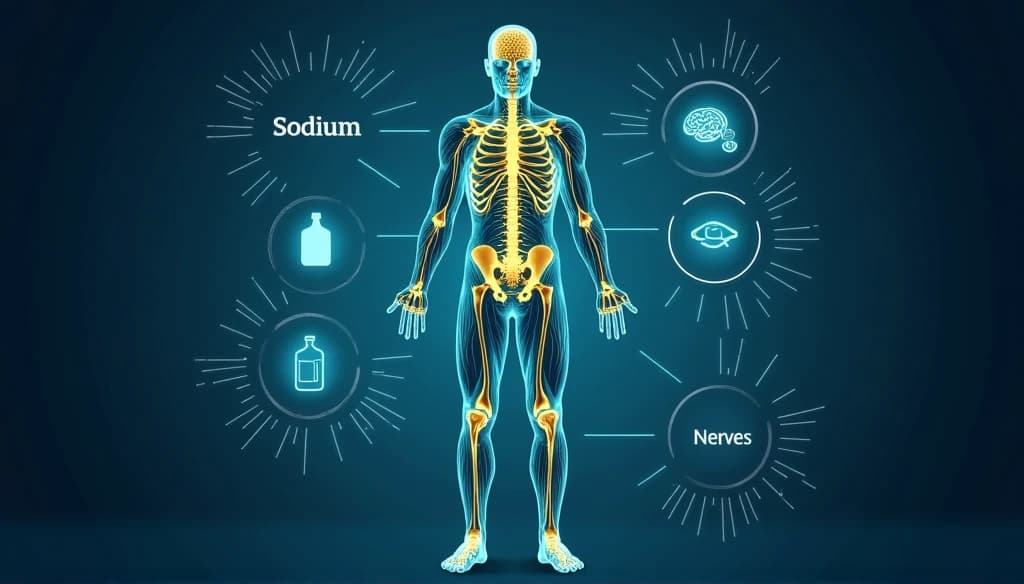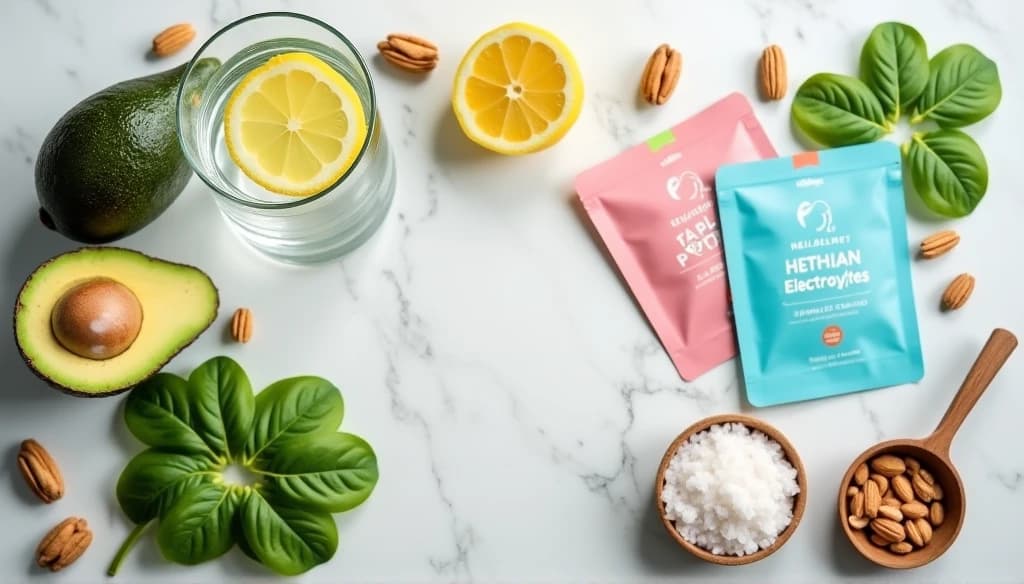Table of Contents
ToggleHave you ever felt sluggish, dizzy, or downright awful while following the ketogenic diet? If so, you’re not alone. These symptoms are often caused by an electrolyte imbalance, a common challenge for keto enthusiasts. But here’s the good news: the right keto electrolytes can help you power through and thrive on your low-carb journey.
In this article, we’ll explore the best keto electrolytes, why they’re crucial, and how to incorporate them into your diet. Whether you’re battling the dreaded keto flu or just looking to optimize your performance, this guide has you covered.
Why Are Electrolytes Important on Keto?

Electrolytes are minerals that help regulate essential bodily functions, including hydration, nerve signals, and muscle function. On keto, your body shifts from burning carbohydrates to fat for energy. While this metabolic switch has many benefits, it also leads to increased water loss, primarily because glycogen stores (your body’s carb reserves) hold water.
As your glycogen stores deplete on keto, you lose water—and with it, vital electrolytes like sodium, potassium, and magnesium. This imbalance can result in symptoms collectively known as the keto flu, including:
- Fatigue
- Muscle cramps
- Headaches
- Dizziness
- Irritability
Replenishing electrolytes is essential to avoid these issues and maintain optimal energy levels, hydration, and overall health.
The Role of Calcium and Other Trace Minerals on Keto
While sodium, potassium, and magnesium are the primary electrolytes to focus on during keto, other trace minerals, like calcium, also play a pivotal role in maintaining overall health and balance. Many keto dieters overlook calcium, but it’s essential for strong bones, muscle function, and nerve signaling. Without adequate calcium intake, you may experience muscle spasms, brittle nails, or even long-term bone density loss.
Why Calcium Matters on Keto
Calcium is often unintentionally reduced on keto because many high-carb dairy products like milk and yogurt are limited. While keto-friendly options like cheese and heavy cream provide some calcium, it may not always be enough to meet your daily requirements. The body tightly regulates calcium levels, and if your diet is deficient, it will pull calcium from your bones, potentially leading to long-term issues like osteoporosis.
How to Get Calcium on Keto
Incorporate these calcium-rich, keto-friendly foods into your diet:
- Cheese: Parmesan, cheddar, and other hard cheeses are not only rich in calcium but also low in carbs.
- Leafy Greens: Kale, spinach, and collard greens are excellent plant-based sources of calcium.
- Fish with Bones: Canned salmon or sardines (with bones included) offer a great calcium boost.
- Almonds: A small handful of almonds provides a good source of calcium, magnesium, and healthy fats.
Supplementing Calcium
If you suspect your calcium intake is too low, consider a calcium supplement. However, it’s important to balance calcium with magnesium to avoid issues like kidney stones.
Calcium may not get as much attention as sodium, potassium, or magnesium, but it’s an essential part of maintaining electrolyte balance and overall health on keto. Don’t underestimate its importance in supporting your long-term success on this diet!
The Big Three: Essential Electrolytes on Keto
1. Sodium
- Why It’s Important: Sodium helps maintain fluid balance, supports nerve function, and prevents muscle cramps.
- Keto Impact: On keto, sodium levels drop as your kidneys excrete more salt. Without enough sodium, you might feel fatigued or dizzy.
- Sources: Pink Himalayan salt, bone broth, salted nuts, and keto-friendly electrolyte supplements.
2. Potassium
- Why It’s Important: Potassium regulates muscle contractions, heart function, and fluid balance.
- Keto Impact: Low-carb diets can lead to potassium loss, increasing the risk of muscle cramps and heart palpitations.
- Sources: Avocados, spinach, mushrooms, salmon, and keto-approved electrolyte drinks.
3. Magnesium
- Why It’s Important: Magnesium plays a key role in over 300 enzymatic reactions, including energy production, muscle relaxation, and bone health.
- Keto Impact: Magnesium deficiency is common due to limited intake of magnesium-rich foods on keto.
- Sources: Almonds, pumpkin seeds, dark chocolate (85% or higher), and magnesium supplements.
Best Keto Electrolyte Supplements

To simplify your electrolyte intake, many people turn to supplements. Here are the top-rated keto electrolyte products based on customer reviews, effectiveness, and quality:
| Product | Electrolytes | Key Features | Price Range |
|---|---|---|---|
| LMNT Recharge | Sodium, Potassium, Magnesium | Zero sugar, no artificial ingredients | $45/30 servings |
| Ultima Replenisher | Magnesium, Potassium | Vegan, keto-friendly, multiple flavors | $20/20 servings |
| Hydrolyte by Perfect Keto | Sodium, Magnesium, Potassium | Clean ingredients, zero carbs | $40/30 servings |
| Hi-Lyte Electrolyte Drops | Sodium, Magnesium, Zinc | Liquid form for easy dosing | $15/48 servings |
| Keto K1000 Electrolyte Powder | Potassium, Sodium, Magnesium | High potassium, zero sugar | $40/50 servings |
How to Incorporate Electrolytes Into Your Keto Diet

Maintaining proper electrolyte levels doesn’t have to be complicated. Here are some practical tips:
1. Salt Your Food
Adding a pinch of Himalayan or sea salt to your meals can significantly boost sodium intake.
2. Drink Bone Broth
Bone broth is rich in sodium, magnesium, and collagen, making it a keto-friendly superfood.
3. Focus on Potassium-Rich Foods
Incorporate keto-approved potassium sources like avocados, spinach, and mushrooms into your daily meals.
4. Take Supplements
Supplements are an easy way to ensure you’re getting an adequate balance of sodium, potassium, and magnesium.
5. Stay Hydrated
Drinking water is essential, but it’s even better to pair it with electrolyte drops or powders to replenish lost minerals.
Signs of Electrolyte Imbalance
It’s important to recognize the signs of an electrolyte imbalance so you can adjust your intake accordingly. Common symptoms include:
- Persistent muscle cramps
- Nausea or vomiting
- Fatigue or weakness
- Irregular heartbeat
- Brain fog
If you experience these symptoms, consider increasing your electrolyte intake or consulting a healthcare professional.
Comparing the Top Keto Electrolyte Products
Here’s a closer look at how the top keto electrolyte supplements stack up:
| Product | Sodium (mg) | Potassium (mg) | Magnesium (mg) | Other Ingredients |
|---|---|---|---|---|
| LMNT Recharge | 1000 | 200 | 60 | No sugar, clean label |
| Ultima Replenisher | 0 | 250 | 100 | Stevia, natural flavors |
| Hydrolyte by Perfect Keto | 500 | 250 | 60 | No carbs, keto-friendly |
| Hi-Lyte Drops | 150 | 0 | 50 | Liquid, easy to use |
| Keto K1000 | 0 | 1000 | 120 | High potassium formula |
Final Thoughts
Electrolytes are a cornerstone of success on the ketogenic diet. By staying proactive and incorporating the right balance of sodium, potassium, and magnesium, you can prevent the dreaded keto flu, optimize your energy, and feel your best.
Whether through supplements, whole foods, or a combination of both, maintaining electrolyte balance is key to thriving on keto. Try the recommended products above, listen to your body, and adjust your intake as needed.
Don’t let an electrolyte imbalance derail your keto journey—stay hydrated, stay balanced, and stay strong!
FAQs About Keto Electrolytes
How much sodium should I consume on keto?
Aim for 3,000–5,000 mg of sodium per day, depending on your activity level and how much you sweat.
Can too many electrolytes be harmful?
Yes, excessive electrolytes can lead to hypernatremia (high sodium) or hyperkalemia (high potassium). Always balance your intake.
Do I need electrolyte supplements if I eat whole foods?
Not necessarily. If your diet includes enough electrolyte-rich foods, you might not need supplements.
What are the best times to take electrolytes on keto?
Spread your intake throughout the day, especially before workouts or during periods of fatigue.
Can I use sports drinks for electrolytes on keto?
Most sports drinks contain added sugars. Opt for keto-friendly electrolyte powders or drops instead.





